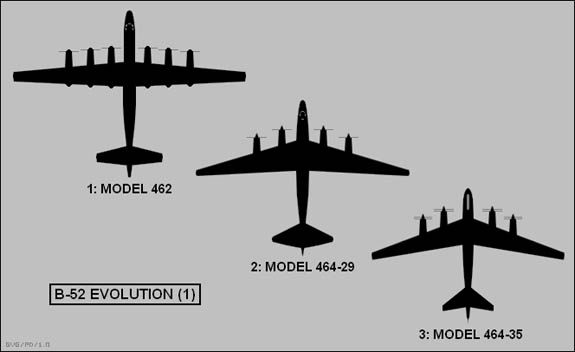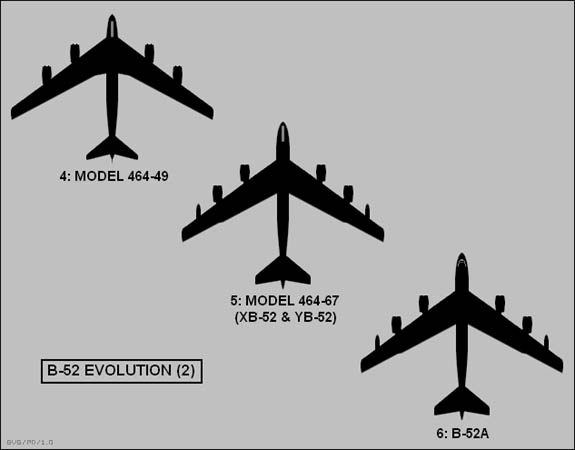WARBIRDS RESOURCE GROUP > VIETNAM > STRATOFORTRESS > PREVIOUS PAGE
Design & Development
On 5 June 1946, Boeing's Model 462, a straight-wing aircraft powered by six Wright T-35 turboprops with a gross weight of 360,000 pounds (160,000 kg) and combat radius of 3,110 statute miles (2,700 nmi, 5,010 km), was declared the winner. On 28 June 1946, Boeing was issued a letter of contract for US$1.7 million (1946 dollars) to build a full-scale mock-up of the new XB-52 and do preliminary engineering and testing. However, by October 1946, the Air Force began to express concern about the sheer size of the new aircraft and its inability to meet the specified design requirements. In response, Boeing produced Model 464, a smaller four-engine version with a 230,000 pound (105,000 kg) gross weight, which was briefly deemed acceptable.


The outright cancellation of the Boeing contract on 11 December 1947 was staved off by a plea from its president William McPherson Allen, and in January 1948 Boeing was instructed to thoroughly explore recent technological innovations, including aerial refueling and the flying wing. Noting stability and control problems Northrop was experiencing with their YB-35 and YB-49 flying wing bombers, Boeing insisted on a conventional aircraft, and in April 1948 presented a US$30 million (1948 dollars) proposal for design, construction, and testing of two Model 464-35 prototypes. Further revisions of specifications during 1948 resulted in an aircraft with a top speed of 513 miles per hour (445 kn, 825 km/h) at 35,000 feet (10,700 m), a range of 6,909 statute miles (6,005 nmi, 11,125 km), and a 280,000 pounds (125,000 kg) gross weight which included 10,000 pounds of bombs and 19,875 US gallons (75,225 L) of fuel.
Entering the Jet Age
In May 1948 the AMC asked Boeing to incorporate the previously discarded, but now more fuel-efficient, jet engine into the design. This resulted in Boeing developing yet another revision — in July 1948, Model 464-40 substituted Westinghouse J40 turbojets for the turboprops. Nevertheless, on 21 October 1948, Boeing was told to create an entirely new aircraft using Pratt & Whitney J57 turbojets.
On 25 October, Boeing engineers produced a proposal and a hand-carved model of 464-49. The new design built upon the basic layout of the B-47 Stratojet with 35° swept wings, eight engines paired in four underwing pods, and bicycle landing gear with wingtip outrigger wheels. A notable feature of the landing gear was the ability to pivot the main landing gear up to 20° from the aircraft centerline to increase safety during crosswind landings. The aircraft was projected to exceed all design specifications. Although the full-size mock-up inspection in April 1949 was generally favorable, range again became a concern since the J40s and the early model J57s had excessive fuel consumption.
Despite talk of another revision of specifications or even a full design competition among aircraft manufacturers, General LeMay, now in charge of Strategic Air Command, insisted that performance should not be compromised due to delays in engine development. In a final attempt to increase the range, Boeing created the larger 464-67, stating that once in production, the range could be further increased in subsequent modifications. Following several direct interventions by LeMay, on 14 February 1951 Boeing was awarded a production contract for 13 B-52As and 17 detachable reconnaissance pods. The last major design change, also at the insistence of General LeMay, was a switch from the B-47 style tandem seating to a more conventional side-by-side cockpit which increased the effectiveness of the copilot and reduced crew fatigue. Both XB-52 prototypes would feature the original tandem seating arrangement with a framed bubble-type canopy.
The YB-52 (actually, the second XB-52 with more operational equipment) first flew on 15 April 1952, a 2 hour 21 minute flight from Renton Field in Renton, Washington to Larson AFB with Boeing test pilot Alvin M. Johnston and Air Force Lieutenant Colonel Guy M. Townsend. The XB-52 followed on 2 October 1952. The thorough development, including 670 days in the wind tunnel and 130 days of aerodynamic and aeroelastic testing, paid off with smooth flight testing. Encouraged, the Air Force increased its order to 282 B-52s.
Only three of the 13 B-52As ordered were built. All were returned to Boeing, and used in their test program. On 9 June 1952 the February 1951 contract was updated to order the aircraft under new specifications. The final ten—the first aircraft to enter active service—were completed as B-52Bs. At the roll out ceremony on 18 March 1954, Air Force Chief of Staff, General Twining said:
“The long rifle was the great weapon of its day. ...Today this B-52 is the long rifle of the air age.”
In informal circumstances, the official name Stratofortress was rarely used; personnel involved with the aircraft most commonly referred to it as BUFF (Big Ugly Fat F####r). The more polite version of this is often quoted as Big Ugly Fat Fellow.
Service modifications
In November 1959, SAC initiated the Big Four modification program (also known as Modification 1000) for all operational B-52s except early B models. The program was completed by 1963. The four modifications were:
1. Ability to perform all-weather, low-altitude (below 500 feet (150 m)) interdiction as a response to advancements in Soviet Union's missile defenses. The low-altitude flights were estimated to accelerate structural fatigue by at least a factor of eight, requiring costly repairs to extend service life.
2. Ability to launch AGM-28 Hound Dog standoff nuclear missiles
3. Ability to launch ADM-20 Quail decoys
4. An advanced electronic countermeasures (ECM) suite
The ability to carry up to 20 AGM-69 SRAM nuclear missiles was added to G and H models starting in 1971 . Fuel leaks due to deteriorating Marman clamps continued to plague all variants of the B-52. To this end, the aircraft were subjected to Blue Band (1957), Hard Shell (1958), and finally QuickClip (1958) programs. The latter fitted safety straps which prevented catastrophic loss of fuel in case of clamp failure.
Ongoing problems with advanced avionics were addressed in the Jolly Well program, completed in 1964, which improved components of the AN/ASQ-38 bombing navigational computer and the terrain computer. The MADREC (Malfunction Detection and Recording) upgrade fitted to most aircraft by 1965 could detect failures in avionics and weapons computer systems, and was essential in monitoring the Hound Dog missiles. The electronic countermeasures capability of the B-52 was expanded with Rivet Rambler (1971) and Rivet Ace (1973).
Structural fatigue, exacerbated by the change to low-altitude missions, was first dealt with in the early 1960s by the three-phase High Stress program which enrolled aircraft at 2,000 flying hours. This was followed by a 2,000-hour service life extension to select airframes in 1966-1968, and the extensive Pacer Plank reskinning completed in 1977. The wet wing introduced on G and H models was even more susceptible to fatigue due to experiencing 60% more stress during flight than the old wing. The wings were modified by 1964 under ECP 1050. This was followed by a fuselage skin and longeron replacement (ECP 1185) in 1966, and B-52 Stability Augmentation and Flight Control program (ECP 1195) in 1967.
In 2007 the LITENING targeting pod was fitted and commissioned increasing the combat effectiveness of the aircraft during day, night and under-the-weather conditions in the attack of ground targets with a variety of standoff weapons under the guidance of LASERs and the help of high resolution forward-looking infrared sensor (FLIR) for visual display in the infrared portion of the electromagnetic spectrum and charged coupled device (CCD-TV) camera used to obtain target imagery in the visible portion, this technology could also be used in real-time transmission to ground communications networks and government agencies to gather battlefield intelligence, assess battlefield damage, assess terrorist activities and counter drug activity, further advancing the B-52H's capabilities and uses.
Fuel research platform
In September 2006, the B-52 became one of the first US military aircraft to fly using 'alternative' fuel. Syntroleum, a leader in Fischer-Tropsch (FT) technology, announced that its Ultra-Clean jet fuel had been successfully tested in a B-52. It took off from Edwards Air Force Base with a 50/50 blend of FT and traditional JP-8 jet fuel which was burned in two of the eight engines on the aircraft. This marked the first time that FT jet fuel was tested in a military flight demo, and is the first of several planned test flights.
On 15 December 2006, tail number 61-0034, Wise Guy took off from Edwards with the synthetic fuel blend powering all eight engines, the first time an Air Force aircraft was completely powered by the mixture. The test flight was captained by Major General Curtis Bedke, commander of the Edwards Flight Test Center, the first time in 36 years that the installation's commander performed a first flight in a flight test program. The flight lasted seven hours, reached an altitude of 48,000 feet, and was considered a success.
On 8 August 2007, Air Force Secretary Michael Wynne certified the B-52H as fully approved to use the FT blend, marking the formal conclusion of the test program.
This program is part of the Department of Defense Assured Fuel Initiative, an effort to develop secure domestic sources for the military energy needs. The Pentagon hopes to reduce its use of crude oil from foreign producers and obtain about half of its aviation fuel from alternative sources by 2016. With the B-52 now approved to use the FT blend, the USAF will use the test protocols developed during the program to certify the C-17 Globemaster III and then the B-1B to use the fuel. The Air Force intends to test and certify every airframe in its inventory to use the fuel by 2011.
Future of the B-52
The Air Force intends to keep the B-52 in service until at least 2040, an unprecedented length of service for a military aircraft. B-52s are periodically refurbished at the USAF maintenance depots such as Tinker Air Force Base, Oklahoma.
Boeing suggested re-engining the B-52H fleet with the Rolls-Royce RB211 534E-4. This would involve replacing the eight Pratt & Whitney TF33s (total thrust 8 × 17,000 lb) with four RB211s (total thrust 4 × 37,400lb). The RR engines will increase the range and payload of the fleet and reduce fuel consumption. However, the cost of the project would be significant. Procurement would cost approximately US$2.56 billion (US$36 million × 71 aircraft). A General Accounting Office study of the proposal concluded that Boeing's estimated savings of US$4.7 billion would not be realized. They found that it would cost the Air Force US$1.3 billion over keeping the existing engines. This was subsequently disputed in a Defense Sciences Board report in 2003 and revised in 2004 that identified numerous errors in the prior evaluation of the Boeing proposal, and urged the Air Force to re-engine the aircraft without delay. Further, the DSB report stated the program would save substantial funds, reduce greenhouse gas emissions, and increase aircraft range and endurance, duplicating the results of a Congressionally funded US$3M program office study conducted in 2003.
The USAF continues to rely on the B-52 because it remains an effective economical heavy bomber, particularly in the type of missions that have been conducted since the end of the Cold War, mainly against nations that have limited air defense capabilities. The B-52's capacity to "loiter" for extended periods over (or even well outside) the battlefield, while delivering precision standoff and direct fire munitions, has been a valuable asset in conflicts such as Operation Enduring Freedom in Afghanistan.
The speed and stealth of the B-1 Lancer and B-2 Spirit have only been useful until enemy air defenses were destroyed, a task that has been swiftly achieved in recent conflicts. The B-52 boasts the highest mission capable rate of the three types of heavy bombers operated by the USAF. Whereas the B-1 averages a 53% ready rate, and the B-2 achieved a 26%, the B-52 averages 80%.
Sources:
Wikipedia: B-52 Stratofortress
WARBIRDS RESOURCE GROUP > VIETNAM > STRATOFORTRESS > PREVIOUS PAGE
